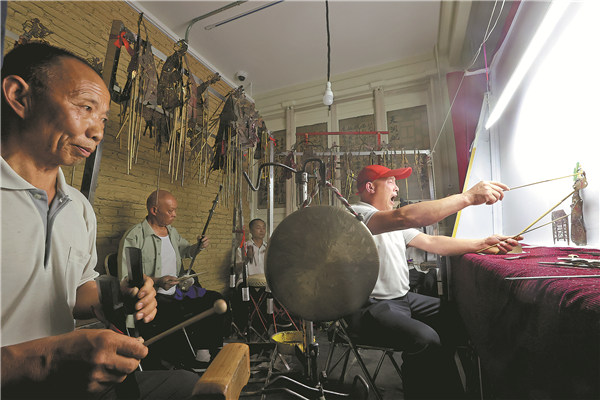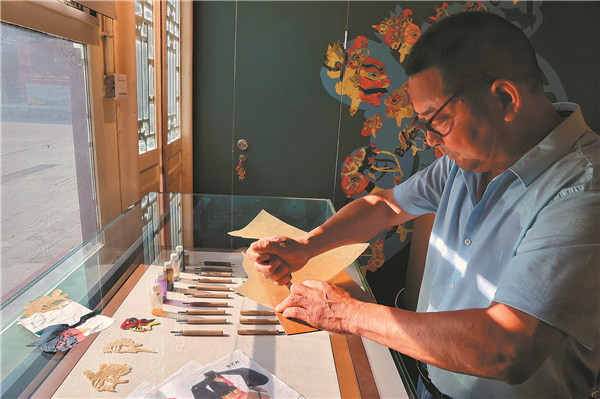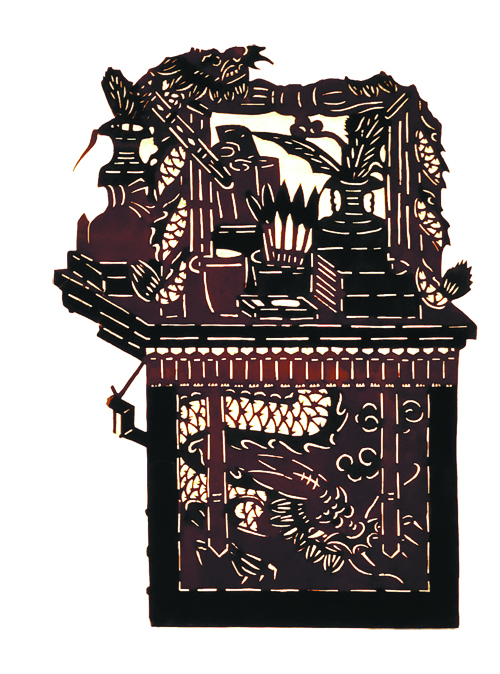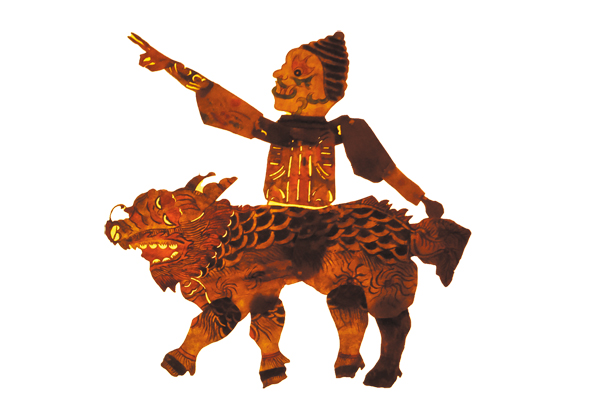


A shadow puppetry troupe performs at an exhibition at Prince Kung's Palace Museum in Beijing. [Photo by Jiang Dong/China Daily]
As the familiar melodies that once echoed through his childhood fill the air at Prince Kung's Palace Museum in downtown Beijing, 53-year-old Liang Rongshan is transported back in time.
These tunes, once played by his father and grandfather, now resonate through the hands of his fellow troupe members during a puppet show-themed exhibition. Liang feels a wave of nostalgia. With a deft hand, he begins to demonstrate his craft, cutting intricate puppet silhouettes from cow leather for an eager audience.
As a third-generation shadow puppet performer and sculptor in Zhushan county, Shiyan, Hubei province, Liang brings the ancient art alive in the Exhibition of Shadow Puppets From the Collection of Prince Kung's Palace Museum and hopes more people will appreciate its beauty.
"As an art form embodying shadow and light, the craft of shadow puppetry has been passed down through many generations and should be preserved and seen by more," Liang says, adding that due to the popularity of television and smartphones, the art is under threat of extinction.
Running until Aug 15, the exhibition showcases more than 200 exquisite shadow puppets selected from the museum's collection, which boasts over 9,000 pieces. These shadow puppets represent diverse styles from across the country.
Highlighting the flourishing development of Qing Dynasty (1644-1911) shadow puppetry in Beijing, the exhibition recollects the customs of patronizing shadow puppetry troupes in the Qing Dynasty's princely residences, illustrating the historical connection between Prince Kung's Palace and Jizhou shadow puppets from what is now Jizhou district of Tianjin municipality. The palace, a public museum today, was the 18th-century residence of Yixin, Prince Kung (1833-98), a statesman and member of the Qing imperial family. According to historical records, the residence, and those of many other imperial families, used to raise or hire shadow puppet troupes who lived and rehearsed in their rented places in Jizhou area, which is near Beijing.

Liang Rongshan, a member of the troupe, creates a puppet out of cow leather at the event. [Photo by Jiang Dong/China Daily]
As the introduction of the exhibition states: "Shadow puppetry spans thousands of years, witnessing the traces of history, carrying the sediment of time, and exuding a strong folk atmosphere."
During the exhibition, shadow puppet shows by five inheritors from Hubei's Zhushan county perform soothing music and operate complex sculptures, exhibiting lively performances.
Chen Zhongxiang, 83, the oldest in the troupe, says it is not easy to master the techniques, such as improvisational singing, falsetto, simultaneous manipulation of several puppets, and the ability to play various musical instruments.
As a member of one of the last troupes with an average age of over 70, Chen is worried about the future of the folk art. Liang, in his early 50s, is the youngest of the troupe. He is the puppet-making craftsman and is also a singer and a musician.

One puppet on show. [Photo by Jiang Dong/China Daily]
Dating back to the Western Han Dynasty (206 BC-AD 24), piyingxi, or shadow puppetry, which means performance with shadows, is a form of theater using colorful silhouette figures made of leather accompanied by music and singing. Manipulated by puppeteers using rods, the figures create the illusion of moving images on a translucent cloth screen illuminated from behind. It was inscribed on UNESCO's Representative List of the Intangible Cultural Heritage of Humanity in 2011.
Usually made up of five people, a troupe includes a puppeteer, three musicians who play many musical instruments, such as suona (a woodwind instrument), sihu (a four-stringed bowed instrument) and percussion instruments, and a singer who assumes all the roles in the show. The plays pass on stories and ideas regarding cultural history, social beliefs, oral traditions and local customs.
In its heyday, professional shadow puppet troupes abounded, and countless smaller groups formed by families or individuals contributed to about 30 genres. Wealthy, influential families often hired big shadow puppet troupes for religious rituals, weddings, funerals and other occasions.
With their passion and enthusiasm for the art form, folk artists like Liang and Chen are exploring contemporary takes, such as adapting and writing new plays based on traditional practice.

One puppet on show. [Photo by Jiang Dong/China Daily]

